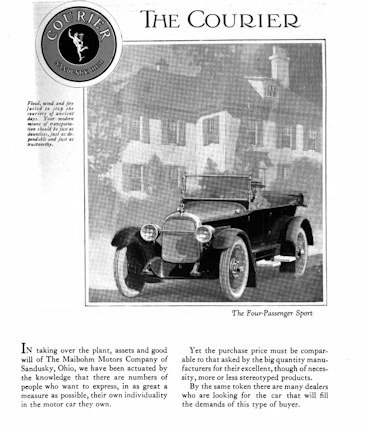Courier Motors Company

The Courier Motors Company was a short-lived American automaker in the early 1920s. The brand name was Courier.
History
The vehicle was the successor to the Maibohm Motors Company built from 1916 to 1922. The beginning of 1922 fell Maibohm engine had massive difficulties to creditors. Following the bankruptcy of Maibohm engine as early as August 1922 Courier Motors Company took control Albert C. Burch, who previously in the commercial vehicle manufacturers Signal Motor Truck Company in Detroit and Clydesdale Motor Truck Company in, Ohio. The company produced the last Maibohm model B-6 in a slightly improved form as Courier Model D. It was believed that by focusing on perfected lubrication of the vehicle, it could improve its market opportunities and built dry sump lubrication for the engine and central chassis lubrication for the chassis in the otherwise almost unchanged vehicle. All these efforts proved ineffective. The production of the Courier Model D remained with 373 units in the model year 1923 well below the 623 produced copies of Maibohm Model B-6 in its last full model year (1921). Until July 1922 another 217 was added, while the then tarnished production of the Courier Model D is included in these 373 vehicles. Details of the production period of the Courier Model D missing, but it should have lasted from the end of 1922 until the end of 1923.
No less than nine body styles are listed. This discrepancy may either mean that models have been announced but not built, or, more likely, that these four are just variants. So, it could be analogous to its predecessor Maibohm Model B-6, the Sport Roadster to a modified version of the occupied Roadster, such as shortened fenders and treads instead of continuous footboards. Analog would be the sport Phaeton and the Sport to see, the latter to another interior with four instead of five seats had. With a high price difference could also be explained by the offered equipment. For Brougham may be noted that this term sometimes for Club Coupe was used. Accordingly, this would have been an upgraded coupe version with five instead of three seats.
In addition to the lubrication systems for the engine and chassis, the basic equipment included a nickel-plated radiator grille and headlamps with a dimming device. Open models had equipment in Spanish leather, and for closed stands a selection of imported fabrics was available. The customer could choose from five colours.
The specifications of the Courier Model D are thus largely identical to those of the Maibohm Model B / B-6. Deviations could be detected for the engine unusual dry sump lubrication for the engine and central chassis lubrication for the chassis. , the carburettor, the steering and some body styles. Of these there were a total of nine. The top-controlled six - cylinder engine had a displacement of 3.2 litres; the performance is different with 46 bhp.
The water-cooled six - cylinder engine was purchased from Falls. These were a modern engine with a one-piece moulded block and removable cylinder head, The Tillotson gasifier of the previous year was no longer used for the mixture Instead, they resorted back to the previously installed Stromberg. The manufacturer stated the fuel consumption at 20 MPG Accordingly, the Courier consumes a quart (0.95 litres) of oil to 500 miles. Like its predecessor, the vehicle is highly likely to have a honeycomb radiator, battery ignition, 6-volt system and fuel delivery via vacuum. The power transmission takes place via a dry disc clutch on a blocked with the engine, conventional, unsynchronized three-speed gearbox with reverse gear and by means of cardan shaft to that with differential in the rear axle.
The wheel base is compared with the previous model unchanged 116 inches The robust chassis is provided as a conventional lead frame constructed. It consists of two cranked side rails and five trusses, of which the second (from the front) supports the engine and gearbox and the rear most carries the fuel tank. Typically, the rigid axles are front and rear. On the Maibohm Model B and B-6 until model year 1921.


